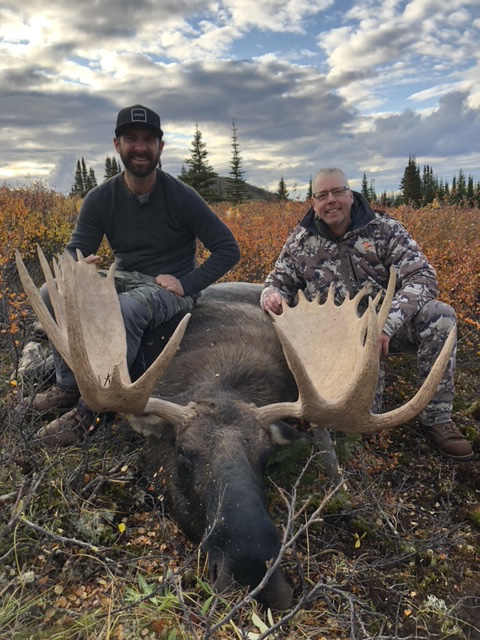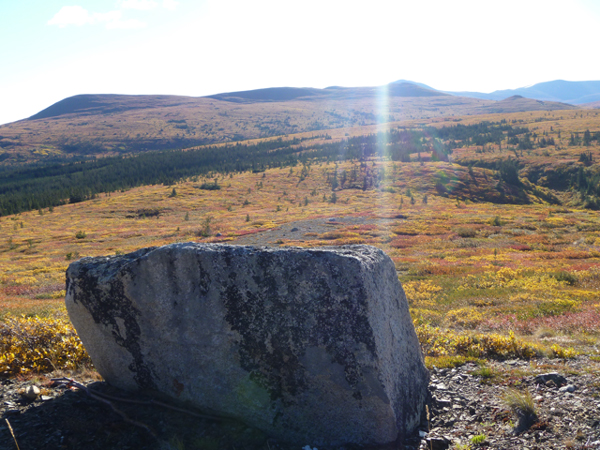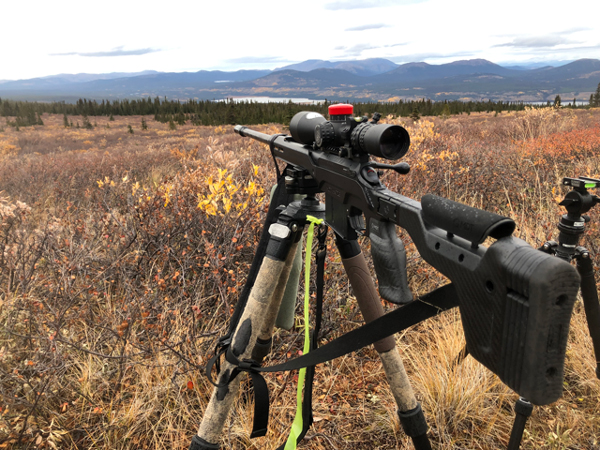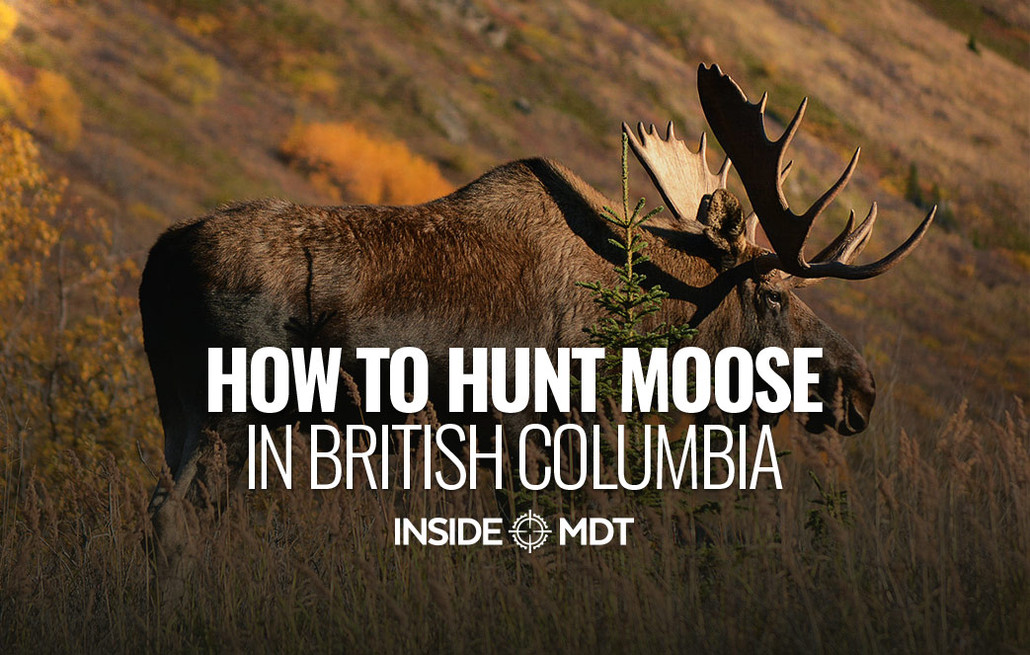Posted by Alan Homer on 2023 Nov 9th
How to Hunt Moose in British Columbia - Inside MDT
In this blog, I'm sharing my knowledge and experiences hunting Alaskan Yukon Moose in Northern British Columbia (B.C.). To start, I've been hunting moose in Northern B.C. Since 1998, I haven't missed a trip, and since 2007, I have successfully harvested a moose every year—that's a lot of moose and a lot of experience. I never had a mentor for moose hunting. I was pretty much self-taught, other than watching the DVDs of the time or chatting with other moose hunters.

This is a bull I called out of the heavy timber in 2021 with my son. It was his first moose hunt.
FINDING AN AREA TO HUNT MOOSE
That seems to be the biggest challenge nowadays. Hunting in B.C. can constrain you to Limited Entry Hunting (a lottery draw) or a few areas of B.C. that are open with antler restrictions. An important note: hunting the Yukon, Northwest Territory, or Alaska may have more options for open areas. But moose hunting in those areas takes a lot of work to access. You don't want to shoot a moose way in the backcountry and then pack it out on your back—it's a logistical nightmare. These animals are just way too big for that. Proper planning and preparation are a must. It's not easy finding a good area to hunt, but doing your homework and using tools like Google Earth or onX Hunt or looking into hunting forums and chatting with the local Conservation Officer will increase your odds.
More:How To Hunt Stone Sheep In British Columbia

This is the biggest bull I have harvested; he was 60" even. The moose quarters dwarf my ATV. It would take many trips to backpack a moose like this or any size out.
BEST TIME OF YEAR TO HUNT MOOSE
Now that you have an area you plan on hunting, the next step is looking into the time of year to go. I've found success hunting in the second week of September. Depending on the weather, the moose rut should be starting or about to start. I've shot most of my bigger bulls from the 10th to the 15th of September. They were just out cruising and covering the country looking for cows. Cow calling and a decoy will work as moose are very vocal mammals. During the pre-rut, the smaller bulls will be with the cows, hoping to keep them long enough so they can breed them when they come into their estrus. That is why the big bulls are out cruising, so they can find cows that are ready to breed, breed them, then move on and keep looking for more. If they have a group of cows, they will stay with them for a while.

One of the mountains I like to climb to glass for moose. I can see for miles and up 3 different valleys. This gives me a great vantage point.
HOW TO FIND MOOSE IN A NEW AREA
I like to hunt for moose in the mountains. If I am in a new area, I try to find a high vantage point where I can see a lot of country. I will climb up to a vantage point in the dark and then spend the entire day searching for moose. I generally plan on staying up there until the last light. If I don't spot any moose, I'll find another area for the next day. I'll usually blast a cow call while glassing, hoping to stir up bulls. If I spot moose, I will watch them and devise a game plan. I ask myself the following questions: Do I have time to stalk them? Is there more than one moose you'll have to keep an eye on so you won't get detected? What is the wind doing? Can I get an ATV or any other means of transportation close to the moose (remember, these animals are enormous and heavy)? Is the bull you're looking at legal to shoot? In most areas of B.C., for the bull to be legal to shoot, it must have at least three brow tines or ten points, or an immature, which is two points or less on one side. Depending on what province or state you are hunting, these requirements will be different. When stalking, pick a route that will keep the wind in your favor and try to get to an advantageous spot that will get you above the moose undetected. Always keep an eye out for other moose you never noticed that could blow your stalk and alert the moose of your presence.

This is one of the areas I sit and call from. I notice I can see a lot of country. I call it the sniping rock. I have taken a couple of moose and a wolf from this rock in the past years.
I remember a few years back when we spotted a bull and a cow in the middle of the rut a few miles away. It took us about an hour or so to get to where we had last spotted them. Unfortunately, they had gone into the thick timber when we arrived. We then moved into a better vantage point—a high spot with the wind in our favor where we started calling. After about an hour of aggressive calling, he came out of the timber, and we harvested him 80 yards away. It was 10:30 in the morning.
TOOLS OF THE TRADE
Some of these may seem odd. But over the years, I've learned to depend on these. For starters, I have a shoulder blade from a previously harvested moose. I use it to rake against trees or shrubbery to help lure in large mammals. Occasionally, I'll use the "moose in heat" scent, but it's not always successful. Paying attention to the wind direction is more important than some of the tricks out there. I do carry a decoy, and it has proved very effective. I do not use a moose call or tube of any sort other than my hand and mouth—I don't like gimmicks. As previously stated, moose are very vocal, so learn some moose calls. YouTube has plenty of how-to-call videos to get you started. I also carry a wind checker—just powder in a bottle.

Being prepared and ready to shoot was key in this setup. This is just before I called a nice bull out of the timber and harvested him undetected.
TIPS FOR CALLING MOOSE
Once in my glassing, hunting, or calling spot, I will start with a cow call about medium volume. Although I have been very close to cows when they call, and they are very loud, I still always do the first few calls a little quieter. I will call about every twenty minutes, but once I finish, I listen. You are listening for a bull calling back, antler raking noises, or branches breaking. After a few more calls, I'll increase the volume. If I hear a bull but cannot see him or know one is nearby, I will rake the shoulder blade on some brush, do some bull calls, and set up my moose decoy. That will usually bring him into sight, but in my experience, he will leave in a hurry if you are too aggressive with the raking, and it's a younger bull.
Always be ready for the unexpected. Have your rifle set up to shoot. Be ready to use a bipod, tripod, shooting sticks, a tree limb, a backpack, etc., to support your rifle. They've come in quietly on more than one occasion. Also, you never know if you are calling in a predator like a grizzly bear or a wolverine, as I have had both come in, so be prepared. Good luck out there, and be safe.
HUNTING RESOURCES FROM MDT
- Premium Lightweight Hunting Build
- Hunting Drills for Success
- Necessities for a Backcountry Hunt
- MeatEater: Dialing in your Kit for 2023
- Staying Mentally Strong in the Backcountry
- Fitness for Backcountry Hunting
- How Shooting Matches Makes You a Better Hunter
- Tips For A Successful Antelope Hunt
- Analysis: Long-Range Hunting
- Why The Triple Pull CKYE-POD is a Guides Best Friend
- Hunting In Inclement Weather
- Maximize Performance with Mental Imagery
- Sheep Hunting in Kyrgyzstan
- Are You Ready for Your Hunt?
- The Ethical Shot
- The Modern Hunting Vest
- Modern Hunting Rifles with Scott Satterlee
- Tag Your Hunting Truck
- How To Hunt Stone Sheep In British Columbia
- ABOUT THE AUTHOR
Alan Homer lives in British Columbia. He is an accomplished competitive shooter and hunter and owns the BCExtremeOutdoorsman YouTube Channel. He can be reached via Instagram @bcextremeoutdoorsman.


 CAD
CAD
 Euro
Euro
